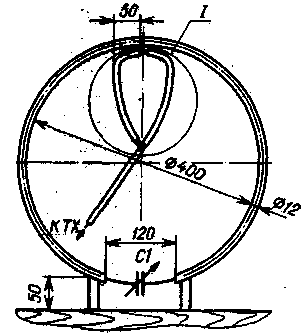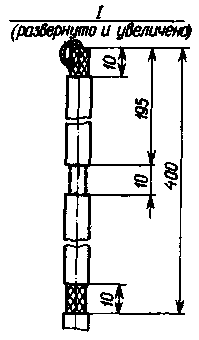 Free technical library
Free technical library
Small loop antenna. Encyclopedia of radio electronics and electrical engineering

Encyclopedia of radio electronics and electrical engineering / HF antennas
 Comments on the article
Comments on the article
An interesting version of a small-sized loop antenna for amateur KB radio stations was proposed by the West German shortwave DF91V. Small-sized frames - with a perimeter significantly smaller than the operating wavelength - are referred to as the so-called magnetic antennas, since they respond (if we are talking about radio reception) to the magnetic component of the electromagnetic wave. This results in a number of advantages. Firstly, such an antenna does not require a good (in the radio engineering sense of the word) "ground", i.e., appropriate "balances", and secondly, the magnetic component of the wave penetrates deeper into the room. Its small size allows it to be used as a balcony or even indoor transmitting antenna.
The quality factor of the frame is very large (several hundreds), so when changing the operating frequency, it must be rebuilt. This shortcoming is compensated to a certain extent by the suppression of signals from interfering stations during reception, as well as harmonics and other spurious emissions during transmission (up to 35 dB for the second harmonic). The OF9IV antenna (see figure) is an open ring of copper tube, inside which there is a frame of insulated copper wire with a cross section of 8 mm2 in an insulating sheath (sheath diameter is slightly smaller than the inner diameter of the tube). Do not use a tube and a frame made of other materials, otherwise the efficiency of the antenna will noticeably decrease.


The frame is tuned with a variable capacitor C1; its rotor is connected to a small electric motor through a gearbox. With the dimensions indicated in the figure and the capacitor C1 with a capacity of 15 ... 220 pF, the antenna can be tuned within 10 ... 30 MHz, which allows it to be used in four amateur bands. The gap between the plates of the rotor and stator of the capacitor must be at least 1,5 mm with a transmitter power of up to 100 W and, accordingly, more if the transmitter is more powerful. It is desirable that the capacitor does not have rubbing contacts. With the help of short metal or insulating racks, the antenna is fixed on a wooden board, on which a capacitor and an electric motor with a gearbox are installed.
The communication loop with the antenna is made from a coaxial cable feeding the antenna with a wave impedance of 50 ohms. From the end of the cable and from the section 400 mm away from it, the outer insulating sheath is removed, and in the middle of this segment, both the sheath and the braid are removed at a length of 10 mm. The inner conductor at the end of the cable is soldered to the braid, and then to the area where the outer insulation was removed from it. The resulting ring is attached with electrical tape to the top of the frame, as shown in the figure.
The standing wave ratio of the described antenna for all amateur bands in the frequency range 10 ... 30 MHz does not exceed 1,3.
With a transmitter power of 5 W with an antenna mounted on a window, DF9IV made QSOs in the 14 MHz band with many countries in Europe, and with a power of 60 W with other continents.
Author: K. Hagenbuchner; Publication: N. Bolshakov, rf.atnn.ru
 See other articles Section HF antennas.
See other articles Section HF antennas.
 Read and write useful comments on this article.
Read and write useful comments on this article.
<< Back
 Latest news of science and technology, new electronics:
Latest news of science and technology, new electronics:
Machine for thinning flowers in gardens
02.05.2024
In modern agriculture, technological progress is developing aimed at increasing the efficiency of plant care processes. The innovative Florix flower thinning machine was presented in Italy, designed to optimize the harvesting stage. This tool is equipped with mobile arms, allowing it to be easily adapted to the needs of the garden. The operator can adjust the speed of the thin wires by controlling them from the tractor cab using a joystick. This approach significantly increases the efficiency of the flower thinning process, providing the possibility of individual adjustment to the specific conditions of the garden, as well as the variety and type of fruit grown in it. After testing the Florix machine for two years on various types of fruit, the results were very encouraging. Farmers such as Filiberto Montanari, who has used a Florix machine for several years, have reported a significant reduction in the time and labor required to thin flowers.
... >>
Advanced Infrared Microscope
02.05.2024
Microscopes play an important role in scientific research, allowing scientists to delve into structures and processes invisible to the eye. However, various microscopy methods have their limitations, and among them was the limitation of resolution when using the infrared range. But the latest achievements of Japanese researchers from the University of Tokyo open up new prospects for studying the microworld. Scientists from the University of Tokyo have unveiled a new microscope that will revolutionize the capabilities of infrared microscopy. This advanced instrument allows you to see the internal structures of living bacteria with amazing clarity on the nanometer scale. Typically, mid-infrared microscopes are limited by low resolution, but the latest development from Japanese researchers overcomes these limitations. According to scientists, the developed microscope allows creating images with a resolution of up to 120 nanometers, which is 30 times higher than the resolution of traditional microscopes. ... >>
Air trap for insects
01.05.2024
Agriculture is one of the key sectors of the economy, and pest control is an integral part of this process. A team of scientists from the Indian Council of Agricultural Research-Central Potato Research Institute (ICAR-CPRI), Shimla, has come up with an innovative solution to this problem - a wind-powered insect air trap. This device addresses the shortcomings of traditional pest control methods by providing real-time insect population data. The trap is powered entirely by wind energy, making it an environmentally friendly solution that requires no power. Its unique design allows monitoring of both harmful and beneficial insects, providing a complete overview of the population in any agricultural area. “By assessing target pests at the right time, we can take necessary measures to control both pests and diseases,” says Kapil ... >>
 Random news from the Archive Random news from the Archive Perception of color changes with the seasons
27.08.2015
Although the eyes of all people are arranged in the same way, visual perception can differ markedly. For example, it is known that in severe depression everything is seen in gray, and this is not a figure of speech at all: a few years ago, researchers from the University of Freiburg measured the activity of retinal cells in several patients with a clinical form of depression and found that their retina does not perceive color contrast well - as if the image, the object were immersed in a gray haze. The thing is that a depressed, depressive state is accompanied by problems with some neurotransmitters, which are needed not only in the nerve chains responsible for emotions, but also for the transmission of a visual impulse. (Let's clarify in brackets that antidepressants had no effect on the "graying" of the world.)
But the perception of color is different in quite healthy people, without psychological problems. For example, we recently wrote about how memory prevents us from distinguishing colors: we tend to reduce all color shades to several colors, which for some reason we have made primary for ourselves. Another factor of "color correction" is cultural and linguistic features: it is believed that if a language has a designation for a color, then a person will distinguish it from others. (A classic example: the word "blue" helps Russian speakers to better distinguish the corresponding color compared to English speakers, who simply refer to this shade as "light blue".)
For all that, for a long time it was believed that everyone sees red, yellow, green and blue in the same way, without discrepancies. From a psychophysiological point of view, all four are called pure colors, while the rest turn out to be composite and are inevitably perceived with shades: for example, orange and red will always be visible, and this is where cultural and psychological “color filters” appear. Subsequently, clarifications arose here: although all people have an idea of \uXNUMXb\uXNUMXbpure red and pure green, in fact, pure colors can be located slightly at different wavelengths. And only yellow seems to be a universal constant: in different cultures it is seen in general in the same way.
However, as researchers from the University of York found out, yellow in our perception is also unstable, only its inconstancy is due not to individual psychological characteristics, and not cultural, but to the season.
In the experiments of Alex Wade (Alex Wade) and his colleagues, 67 men and women participated: they were introduced into a completely dark room, they were given time for their eyes to get used to the darkness, and then they were asked on a special device to choose such a yellow color that seemed to them " real", pure yellow. The experiment was repeated in January and June, and, as the authors of the work in Current Biology write, the choice was different in winter and summer, that is, “winter pure yellow” was different from “pure summer yellow”.
How exactly and where exactly the color balance is corrected, whether at the level of the retina, or already in the visual cortex of the brain, we do not yet know, but the fact itself can be explained by seasonal differences in the environment. In winter, the illumination and color saturation of what we see around us weakens, and a change in color vision probably plays a compensatory role. Moreover, during the day there are no such changes in the vision of yellow. Now it would be interesting to know if there is a seasonality in the perception of other colors, and how those who live in other geographical latitudes see the same yellow color, where winter and summer look different than in the north of England.
|
 Other interesting news:
Other interesting news:
▪ Crab and Shrimp Batteries
▪ solar chimney
▪ Heat resistant bioplastic
▪ The coldest cubic meter in the universe
▪ Music intoxication
 News feed of science and technology, new electronics
News feed of science and technology, new electronics
 Interesting materials of the Free Technical Library:
Interesting materials of the Free Technical Library:
▪ section of the site Dosimeters. Selection of articles
▪ article Sewing polyethylene - with the help of a newspaper. Tips for the home master
▪ article Where did the names of the days of the week come from? Detailed answer
▪ article Operator of a mobile concrete mixer. Job description
▪ article Water level indicator in the room. Encyclopedia of radio electronics and electrical engineering
▪ article Power supply for a radio amateur, 0-30 volts. Encyclopedia of radio electronics and electrical engineering
 Leave your comment on this article:
Leave your comment on this article:
 All languages of this page
All languages of this page
Home page | Library | Articles | Website map | Site Reviews

www.diagram.com.ua
2000-2024







 Arabic
Arabic Bengali
Bengali Chinese
Chinese English
English French
French German
German Hebrew
Hebrew Hindi
Hindi Italian
Italian Japanese
Japanese Korean
Korean Malay
Malay Polish
Polish Portuguese
Portuguese Spanish
Spanish Turkish
Turkish Ukrainian
Ukrainian Vietnamese
Vietnamese


 Leave your comment on this article:
Leave your comment on this article: